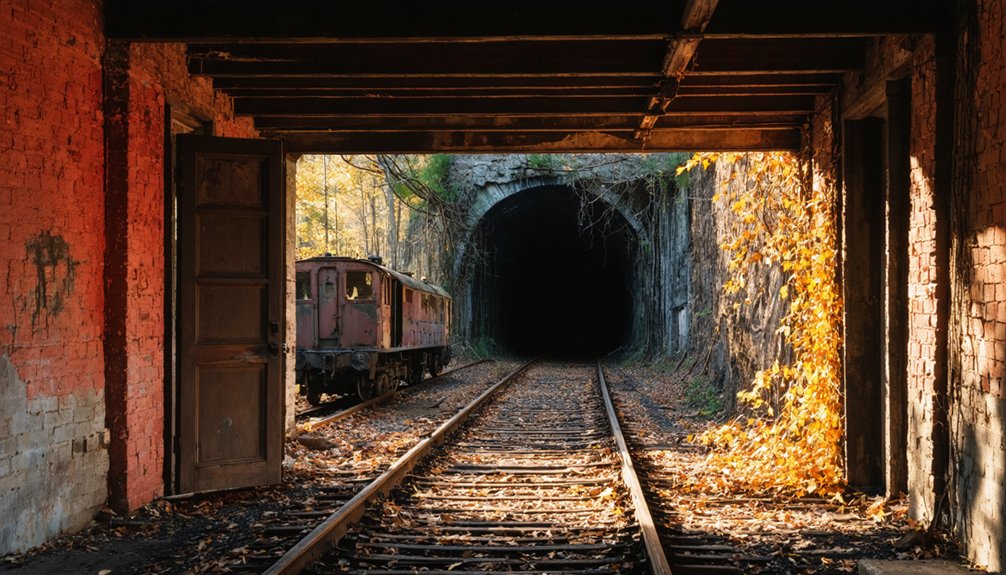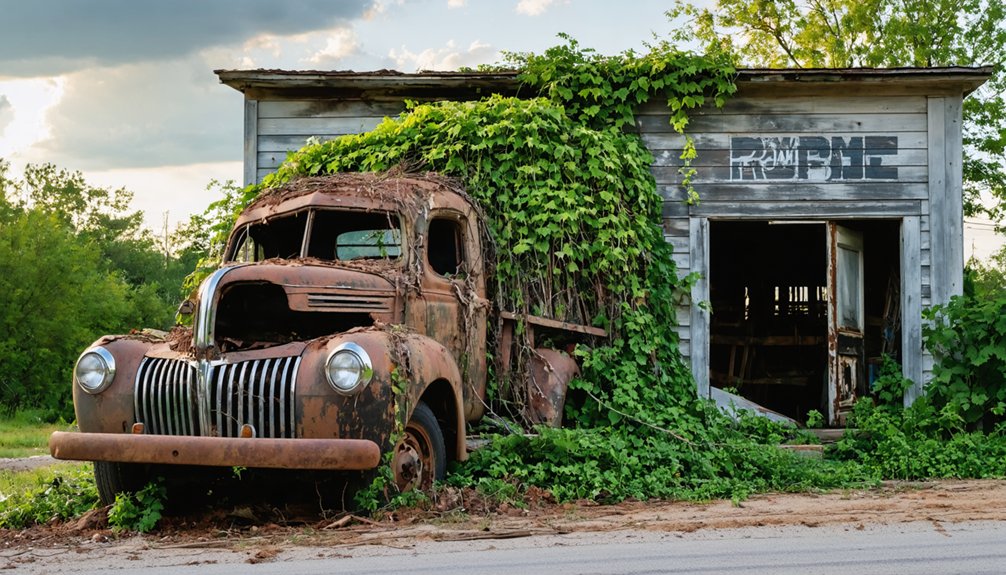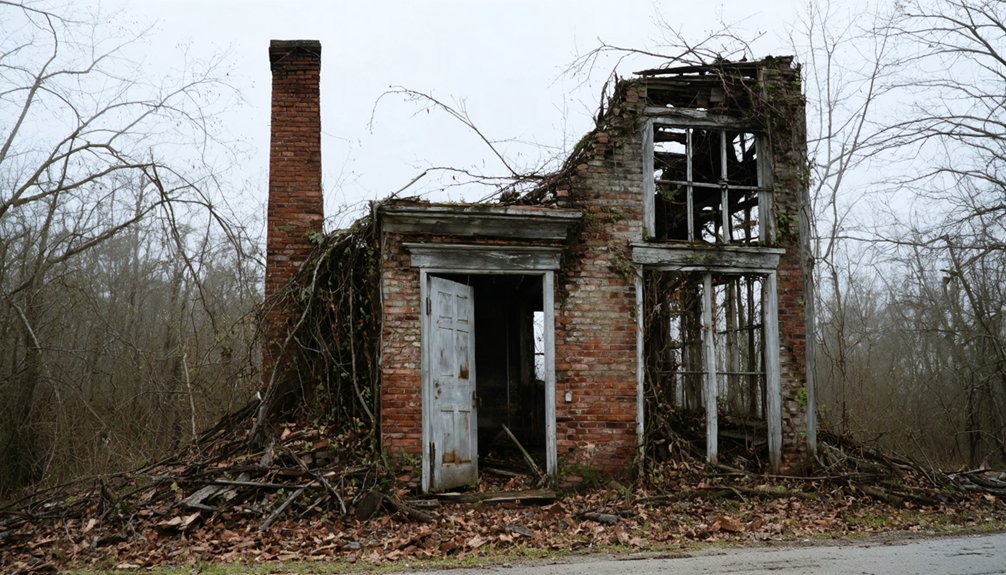You’ll find the Gold Log Mine, formerly known as Story Mine until 1915, in Alabama’s Piedmont region. Gold was discovered here in 1840 during wine cellar excavation, supporting thousands during Alabama’s gold rush. The operation processed 25 tons of ore daily using jaw crushers and stamp mills, yielding approximately $4 per ton. Despite producing $30,000 in gold, the mine’s fate shifted when miners departed for California’s goldfields in 1849. The site’s rich history holds numerous untold stories of determination and struggle.
Key Takeaways
- Gold Log Mine emerged in 1840 after gold discovery during wine cellar construction, supporting thousands during Alabama’s gold rush era.
- The mine community featured temporary shelters and log cabins, with miners facing harsh living conditions and poor sanitation.
- Mining operations processed 25 tons of ore daily, yielding $30,000 in total gold production through stamp mills and crushers.
- The settlement experienced rapid decline when miners left for California’s goldfields in 1849, leaving behind deteriorating structures.
- Water management problems, declining yields, and economic instability ultimately transformed the once-bustling mining camp into abandoned territory.
The Discovery of Gold at Riddles Mill
While Alabama’s gold rush era encompassed several significant mining districts, the discovery of gold at Riddles Mill in Talladega County marked a notable development in the state’s mineral extraction history.
Alabama’s discovery of gold at Riddles Mill stands as a pivotal moment in the state’s rich mining heritage.
You’ll find that the Riddles Mill Mining District emerged during Alabama’s broader gold exploration period, which began around 1830. The region’s geology, characterized by quartz veins and pyrite formations, provided favorable conditions for gold discovery. Like the historic town of Arbacoochee which reached 5,000 residents by 1845, the area attracted numerous prospectors seeking their fortune.
The area’s gold deposits were found within complex vein systems, leading to the establishment of several mining operations, including the nearby Story Gold Mine. Early miners relied on crude labor-intensive processes to extract gold from the deposits, using basic tools such as picks, shovels, and hand drills.
While specific details about the initial gold discovery at Riddles Mill remain limited, the site’s development contributed to the region’s economic growth and attracted settlers who utilized various extraction methods, from basic panning to more sophisticated stamp milling techniques.
Early Days of the Gold Log Mine
The Gold Log Mine emerged from the same gold-bearing Piedmont belt that hosted the Riddles Mill operations, specifically in Talladega County, Alabama.
You’ll find its origins intertwined with mining folklore, as the site was previously known as the Story Mine until 1915. The property’s most fascinating history centers around Dr. Ulrich’s 1,200-acre vineyard, where workers discovered gold while digging a wine cellar tunnel in 1840.
The mine’s economic legacy reflects the broader Alabama gold rush, when towns like Goldville supported thousands of residents. Like many mining operations of the era, miners earned between $0.75 and $1.75 per day for their arduous work. During its peak, the area resembled other bustling mining districts like Arbacoochee district, which employed around 600 men.
You’ll notice the operation’s technical evolution through its infrastructure, from early water-powered stamp mills to more advanced cyanide processing methods.
The mine’s gray, fine-grained schist formations, characterized by wavy foliation and quartz-sericite-chlorite mineralogy, proved essential for gold mineralization.
Mining Techniques and Equipment
At the Gold Log Mine, you’ll find evidence of classic ore processing equipment including jaw crushers and stamp mills that could process approximately 25 tons of material per day.
The operation’s primary crushing circuit utilized stamp batteries dropping 75-80 times per minute to pulverize ore before passing it over amalgamation plates for mercury-based gold recovery. Initial crushing was done using 6 by 10 jaw crushers powered by gasoline engines to reduce material size before further processing. Later operations incorporated modern dredging equipment for more precise extraction methods.
Underground extraction relied on traditional mining tools like hammers, chisels, and pneumatic equipment, while ventilation systems and wooden supports guaranteed safe working conditions in the tunnels.
Early Gold Processing Methods
During gold mining’s earliest phase at Log Mine, miners relied mainly on manual extraction methods to recover precious metals from both placer deposits and exposed quartz veins.
You would’ve found them using basic tools like picks and pans, swirling sediment in water to separate heavier gold particles through gold panning. The ancient process of washing away sediments had been used successfully for thousands of years.
As operations expanded, ore crushing became essential for processing gold-bearing quartz.
Initially, miners used arrastres – simple horse-powered stone mills that ground ore between heavy rocks. This was later upgraded to stamp mills, whose thunderous crushing action could be heard for miles. The introduction of stamp mill banks typically featured five stamps each, with larger mining operations installing multiple banks.
These mechanical crushers greatly improved gold liberation from hard rock, preparing it for further processing through mercury amalgamation. The amalgam would then be heated, vaporizing the mercury and leaving behind purified gold.
Mining Equipment and Tools
Mining operations at Gold Log Mine relied on an extensive array of equipment and tools to efficiently extract and process precious metals.
Miners accessed rich lode and placer deposits throughout the site’s operational period. You’ll find evidence of significant mining advancements through the multiple stamp mills that operated simultaneously, powered by local creek water. Gold production was enhanced using a 10-stamp mill that operated until 1916. The equipment evolution included jaw crushers for initial ore processing, followed by amalgamation plates using mercury to capture gold particles.
The site’s processing capabilities expanded with specialized tools like rocker boxes and panning equipment for stream-based extraction.
For deeper ore deposits, miners employed picks and shovels, while tables covered with blankets served as an innovative separation method.
The mine’s thorough setup also featured cyanide leaching systems for processing low-grade ores, representing the technological progression of Alabama’s mining industry.
Life in the Mining Community
You’ll find that daily life in Gold Log Mine centered around exhaustive manual labor, with miners enduring dangerous underground conditions while support workers maintained the essential surface operations and infrastructure.
Though specific records of Gold Log’s social fabric are limited, the community likely followed regional patterns with basic company housing, minimal amenities, and a company store system typical of Alabama mining settlements.
The harsh working conditions and isolation fostered tight-knit relationships among mining families, who relied on mutual support and simple traditions to maintain morale in their remote industrial setting.
Daily Work and Struggles
Life in the Gold Log mining community revolved around grueling work conditions and economic uncertainty, as evidenced by the 250-foot adits and labor-intensive ore extraction methods.
You’d find yourself hauling ore cars on wooden tracks through dimly lit tunnels, facing constant labor challenges from water intrusion and unstable rock formations.
The economic instability was stark – while some operations yielded $30,000 in gold, many barely broke even.
You’d need to process massive quantities of ore, averaging only 0.19 ounces per ton, to turn a profit.
Your workday would be consumed by manual tasks, from tunnel support to operating water-powered stamp mills.
When mines hit sulphide deposits or flooding became severe, operations would halt, leaving you to seek work elsewhere or shift to California’s promising goldfields.
Community Spirit and Traditions
Despite the physical demands of mining life, strong communal bonds emerged through social institutions and shared traditions at Gold Log. The Methodist church served as the heart of community gatherings, where miners and their families forged solidarity through social events and religious services.
You’ll find that oral traditions played a crucial role, with stories of prospectors like the King brothers being passed down through generations.
The mining community’s resilience manifested through apprenticeship-style knowledge sharing, where experienced miners taught newcomers the intricacies of extraction techniques. This technical expertise evolved from basic manual tools to limited mechanization.
Brick buildings in nearby towns like Chulafinnee demonstrated the community’s commitment to permanence, while local markets sustained both mining operations and family life, creating a self-reliant ecosystem of mutual support.
Living Conditions and Housing
While gold fever drove thousands to Gold Log’s mines, living conditions remained remarkably austere, with most miners dwelling in hastily constructed temporary shelters and tents clustered near extraction sites.
You’d find basic log cabins dotting the landscape, though these structures often lacked proper insulation or flooring, exposing inhabitants to harsh elements and vermin.
The housing challenges extended beyond mere shelter, as sanitation issues plagued the community.
With no organized waste disposal system, you’d have to rely on communal efforts to maintain basic hygiene. Your water would come from nearby streams or wells, frequently contaminated by mining operations.
The proximity of dwellings to active mining areas exposed you to additional hazards, including toxic chemicals and blasting debris, while the dense concentration of temporary housing created fire risks and disease vectors.
Peak Production Years
During the late 19th century, the Gold Log Mine emerged as a significant contributor to Alabama’s mining industry, leveraging advanced milling technology to process approximately 25 tons of ore per day.
You’ll find that peak production coincided with the revival of gold mining across the state, as the mine extracted valuable ore from quartz veins embedded in sericite schist formations.
The mine’s economic impact stemmed from its sophisticated mill operations, which utilized water power to run jaw crushers, stamps, and amalgamation plates.
While yielding about $4 per ton of processed ore, the operation shipped bullion directly to the mint without attempting further concentration.
This streamlined approach, combined with the mine’s advanced stamp batteries and efficient processing methods, positioned Gold Log as a notable producer within Alabama’s broader mining landscape.
The Decline of Operations
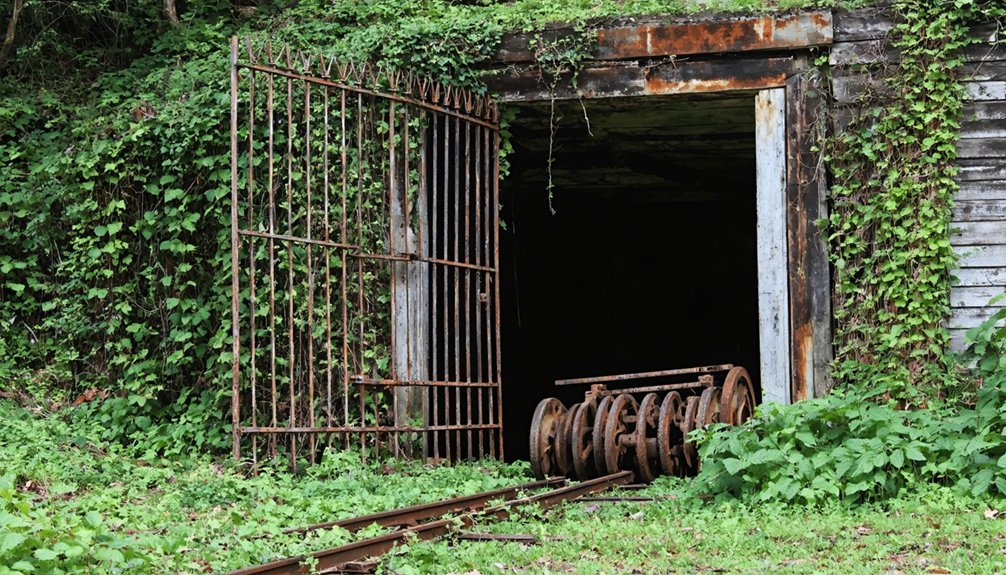
As economic pressures mounted in the late 1840s, the Gold Log Mine experienced a significant operational decline attributed to multiple interconnected factors.
You’ll find that the mine’s small production size and intermittent operations created substantial operational challenges, making it difficult to maintain profitability against larger competitors.
The mine’s economic factors deteriorated rapidly as miners departed for California’s more promising goldfields in 1849.
You’re looking at a operation that struggled with geological complexities, including variable vein widths and water management issues, which drove up extraction costs.
The mine’s dependence on local resources and crude technological capabilities further hindered its sustainability.
These challenges, combined with increasing competition from other mining regions, ultimately led to the mine’s closure with no prospects for revival.
Notable Characters and Stories
Since the Gold Log Mine‘s establishment, several notable figures shaped its operational history and cultural landscape. Dr. Ulrich‘s trades of one-ounce gold bars for cattle and supplies near Goldville earned him recognition, while his operation site became known as Dutch Bend due to locals mistaking his identity.
E. A. Thomas’s leadership as president and manager of the Gold Log Mining Company marked a significant phase in 1915, following his acquisition of the Story Mine.
You’ll find these operators tackled considerable challenges, including the complex issue of graphite interfering with mercury amalgamation. They innovatively solved this through the use of tannic acid derived from red-oak bark ashes.
Their technical expertise proved essential in maintaining operations despite the low-grade ore that characterized the region’s deposits.
Geological Features and Gold Deposits
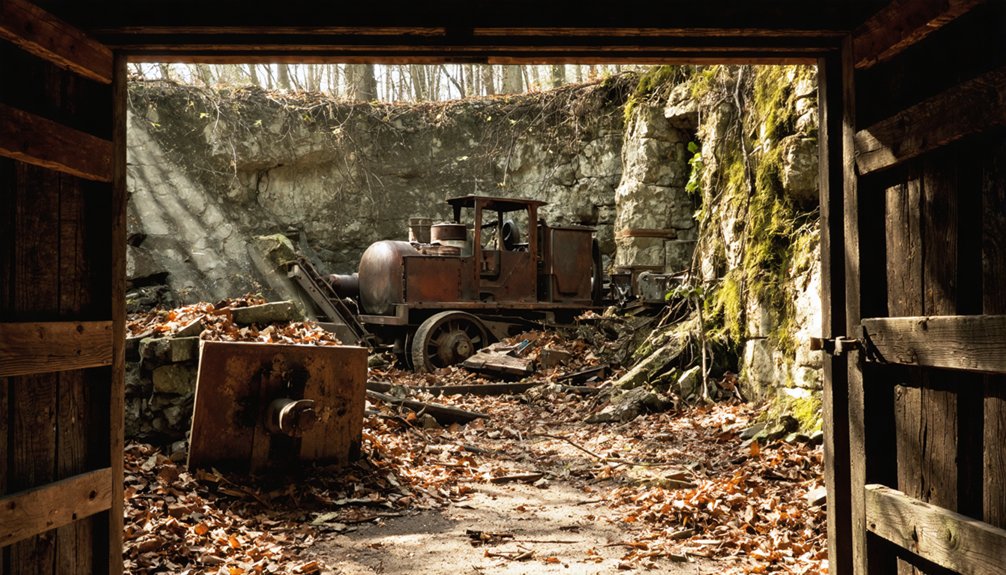
Located in Talladega County, Alabama, the Gold Log Mine exemplifies the complex geological characteristics of the Piedmont Upland physiographic province.
You’ll find the mine situated within micaceous and graphitic schists dating to the Lopingian epoch, where gold-bearing ore aligns with these geological formations.
The mineralization processes created distinctive ore bodies consisting of subparallel lenses of quartz, calcite, and metallic minerals.
You’ll notice how hydrothermal solutions infiltrated along schist foliation planes, depositing gold in various forms. The gold occurs both as visible “freegold” in quartz veins and within oxidized ore zones near the surface.
These deposits showcase typical mesothermal gold-quartz vein characteristics, with ore lenses that can rapidly pinch out or expand within short distances along the vein trend.
Visiting the Historic Site Today
While visiting the Gold Log Mine site today requires careful planning and local knowledge, you’ll find the former mining operation situated approximately 7.5 miles south of Talladega city in rural Alabama.
Before attempting to access this historical location, you’ll need to research current property ownership and obtain necessary permissions, as visitor information is limited.
Always verify property ownership and secure required permissions before visiting this remote historical site, as access details are scarce.
- Access requires vehicle transportation through rural roads near Waldo, Alabama, with no established visitor facilities.
- Surface exploration opportunities exist for photography and historical documentation, though minimal mining infrastructure remains.
- Safety considerations are paramount due to potential hazards typical of abandoned mine sites.
The site has largely returned to its natural state, with forest reclaiming most evidence of past mining activities.
Archaeological enthusiasts and historians should note that any artifacts encountered must remain undisturbed to preserve the site’s historical integrity.
Frequently Asked Questions
Were There Any Major Accidents or Disasters at the Gold Log Mine?
You won’t find any documented major accidents at Gold Log, as historical accident records and mine safety archives show no evidence of disasters or fatalities at this particular mining operation.
What Happened to the Mining Equipment After the Mine Closed?
You won’t find explicit records of mining equipment disposal at this site. Historical preservation data suggests larger items were likely salvaged, while smaller equipment deteriorated or remains undocumented underground.
Did Native Americans Mine Gold in This Area Before European Settlers?
While tribal legends might suggest otherwise, you won’t find evidence of Native mining for gold here. Archaeological records show local tribes worked with copper and other minerals, but didn’t extract gold before Europeans arrived.
How Much Gold Remains Unmined at the Gold Log Mine Site?
You can’t definitively quantify remaining gold since there’s no modern assessment, though unexplored veins likely exist below 30-meter depth where historic gold extraction stopped, suggesting potential unmined deposits.
Were There Any Competing Mines That Caused Conflicts in the Area?
You’ll find extensive mine rivalries documented in the region, with the Gold Log Mine facing territorial disputes from Story Mine, Hicks-Wise, and King Mine operators over water rights and claim boundaries.
References
- https://russelllandshistory.com/gold-mining-in-alabama.html
- https://thediggings.com/mines/usgs10136017
- https://digitalalabama.com/gold-in-alabama/gold-in-tallapoosa-county-alabama-2/20764
- https://thediggings.com/mines/usgs10081367
- https://www.goldfeverprospecting.com/goloinal.html
- https://www.alabamapioneers.com/patron-locations-of-gold-mines-in-alabama-from-1855-newspaper-article/
- https://archive.org/details/pbc.gda.pl.79736_Bulletin_640-I_
- https://www.mindat.org/locentry-509223.html
- https://digitalalabama.com/gold-in-alabama/gold-in-cleburne-county-alabama/13807
- http://alabamaclaycounty.com/wp-content/uploads/2013/05/THARS-GOLD-IN-THEM-THAR-HILLS.pdf
